The Importance of Capturing Local Measurement-Driven Adjustment of Modelled j(NO2)
Abstract
:1. Introduction
2. Methods
2.1. Measured Values of j(NO2)
2.2. Modelled Values of j(NO2)
2.3. Measurement-Driven Adjustment Factor
3. Results and Discussion
3.1. The Need for Local Adjustments to j(NO2)
3.2. 2π vs. 4π Filter Radiometer Values of MDAFs
4. Conclusions and Implications
Author Contributions
Funding
Data Availability Statement
Acknowledgments
Conflicts of Interest
References
- Chen, C.-H.; Chen, T.-F.; Huang, S.-P.; Chang, K.-H. Comparison of the RADM2 and RACM chemical mechanisms in O3 simulations: Effect of the photolysis rate constant. Sci. Rep. 2021, 11, 5024. [Google Scholar] [CrossRef] [PubMed]
- Thiel, S.; Ammannato, L.; Bais, A.; Bandy, B.; Blumthaler, M.; Bohn, B.; Engelsen, O.; Gobbi, G.P.; Gröbner, J.; Jäkel, E.; et al. Influence of clouds on the spectral actinic flux density in the lower troposphere (INSPECTRO): Overview of the field campaigns. Atmos. Chem. Phys. 2008, 8, 1789–1812. [Google Scholar] [CrossRef] [Green Version]
- Wang, W.; Li, X.; Shao, M.; Hu, M.; Zeng, L.; Wu, Y.; Tan, T. The impact of aerosols on photolysis frequencies and ozone production in Beijing during the 4-year period 2012–2015. Atmos. Chem. Phys. 2019, 19, 9413–9429. [Google Scholar] [CrossRef] [Green Version]
- Zhao, S.; Hu, B.; Liu, H.; Du, C.; Xia, X.; Wang, Y. The influence of aerosols on the NO2 photolysis rate in a suburban site in North China. Sci. Total Environ. 2021, 767, 144788. [Google Scholar] [CrossRef]
- Azzi, M.; Johnson, G.M.; Cope, M.E. An introduction to the generic reaction set photochemical smog mechanism. Proc. Elev. Int. Conf. Clean Air Soc. Aust. N. Z. 1992, 2, 451–462. Available online: https://publications.csiro.au/rpr/pub?list=BRO&pid=procite:fd8053cf-f783-48f8-b218-e01de4961266 (accessed on 1 June 2022).
- Jenkin, M.E.; Saunders, S.M.; Pilling, M.J. The tropospheric degradation of volatile organic compounds: A protocol for mechanism development. Atmos. Environ. 1997, 31, 81–104. [Google Scholar] [CrossRef]
- Saunders, S.M.; Jenkin, M.E.; Derwent, R.G.; Pilling, M.J. Protocol for the development of the Master Chemical Mechanism, MCM v3 (Part A): Tropospheric degradation of non-aromatic volatile organic compounds. Atmos. Chem. Phys. 2003, 3, 161–180. [Google Scholar] [CrossRef] [Green Version]
- NCAR. National Centre for Atmospheric Research (NCAR) Tropospheric Ultraviolet and Visible (TUV) Radiation Model v5.3. 2019. Available online: https://www2.acom.ucar.edu/modeling/tropospheric-ultraviolet-and-visible-tuv-radiation-model (accessed on 1 June 2022).
- Neu, J.L.; Prather, M.J.; Penner, J.E. Global atmospheric chemistry: Integrating over fractional cloud cover. J. Geophys. Res. 2007, 112, D11306. [Google Scholar] [CrossRef] [Green Version]
- Monks, P.S.; Granier, C.; Fuzzi, S.; Stohl, A.; Williams, M.L.; Akimoto, H.; Amann, M.; Baklanov, A.; Baltensperger, U.; Bey, I.; et al. Atmospheric composition change—Global and regional air quality. Atmos. Environ. 2009, 43, 5268–5350. [Google Scholar] [CrossRef] [Green Version]
- Junkermann, W.; Platt, U.; Volz-Thomas, A. A photoelectric detector for the measurement of photolysis frequencies of ozone and other atmospheric molecules. J. Atmos. Chem. 1989, 8, 203–227. [Google Scholar] [CrossRef]
- Volz-Thomas, A.; Lerner, A.; Pätz, H.-W.; Schultz, M.; McKenna, D.S.; Schmitt, R.; Madronich, S.; Röth, E.P. Airborne measurements of the photolysis frequency of NO2. J. Geophys. Res. 1996, 101, 18613–18627. [Google Scholar] [CrossRef]
- Elshorbany, Y.F.; Kleffmann, J.; Hofzumahaus, A.; Kurtenbach, R.; Wiesen, P.; Brauers, T.; Bohn, B.; Dorn, H.-P.; Fuchs, H.; Holland, F.; et al. HOx budgets during HOxComp: A case study of HOx chemistry under NOx-limited conditions. J. Geophys. Res. 2012, 117, D03307. [Google Scholar] [CrossRef] [Green Version]
- Bannan, T.J.; Bacak, A.; Le Breton, M.; Flynn, M.; Ouyang, B.; McLeod, M.; Jones, R.; Malkin, T.L.; Whalley, L.K.; Heard, D.E.; et al. Ground and Airborne U.K. Measurements of Nitryl Chloride: An Investigation of the Role of Cl Atom Oxidation at Weybourne Atmospheric Observatory. J. Geophys. Res. 2017, 122, 11154–111165. [Google Scholar] [CrossRef]
- Xue, C.; Zhang, C.; Ye, C.; Liu, P.; Catoire, V.; Krysztofiak, G.; Chen, H.; Ren, Y.; Zhao, X.; Wang, J.; et al. HONO Budget and Its Role in Nitrate Formation in the Rural North China Plain. Environ. Sci. Technol. 2020, 54, 11048–11057. [Google Scholar] [CrossRef]
- Sommariva, R.; Cox, S.; Martin, C.; Borońska, K.; Young, J.; Jimack, P.K.; Pilling, M.J.; Matthaios, V.N.; Nelson, B.S.; Newland, M.J.; et al. AtChem (version 1), an open-source box model for the Master Chemical Mechanism. Geosci. Model Dev. 2020, 13, 169–183. [Google Scholar] [CrossRef] [Green Version]
- Sommariva, R.; Crilley, L.R.; Ball, S.M.; Cordell, R.L.; Hollis, L.D.J.; Bloss, W.J.; Monks, P.S. Enhanced wintertime oxidation of VOCs via sustained radical sources in the urban atmosphere. Environ. Pollut. 2021, 274, 116563. [Google Scholar] [CrossRef]
- Malley, C.S.; Braban, C.F.; Heal, M.R. The application of hierarchical cluster analysis and non-negative matrix factorization to European atmospheric monitoring site classification. Atmos. Res. 2014, 138, 30–40. [Google Scholar] [CrossRef] [Green Version]
- Twigg, M.M.; Di Marco, C.F.; Leeson, S.; van Dijk, N.; Jones, M.R.; Leith, I.D.; Morrison, E.; Coyle, M.; Proost, R.; Peeters, A.N.M.; et al. Water soluble aerosols and gases at a UK background site—Part 1: Controls of PM2.5 and PM10 aerosol composition. Atmos. Chem. Phys. 2015, 15, 8131–8145. [Google Scholar] [CrossRef] [Green Version]
- Coyle, M.; Cape, J.N.; Flechard, C.; Fowler, D.; Helfter, C.; Jones, M.; Kentisbeer, J.; Leeson, S.R.; Leith, I.D.; Mullinger, N.; et al. Meteorological measurements at Auchencorth Moss from 1995 to 2016. Geosci. Data J. 2019, 6, 16–29. [Google Scholar] [CrossRef]
- Bohn, B.; Kraus, A.; Müller, M.; Hofzumahaus, A. Measurement of atmospheric O3 → O(1D) photolysis frequencies using filterradiometry. J. Geophys. Res. 2004, 109, D10S90. [Google Scholar] [CrossRef] [Green Version]
- Webb, A.R.; Bais, A.F.; Blumthaler, M.; Gobbi, G.P.; Kylling, A.; Schmitt, R.; Thiel, S.; Barnaba, F.; Danielsen, T.; Junkermann, W.; et al. Measuring Spectral Actinic Flux and Irradiance: Experimental Results from the Actinic Flux Determination from Measurements of Irradiance (ADMIRA) Project. J. Atmos. Ocean. Technol. 2002, 19, 1049–1062. [Google Scholar] [CrossRef]
- Mérienne, M.F.; Jenouvrier, A.; Coquart, B. The NO2 absorption spectrum. I: Absorption cross-sections at ambient temperature in the 300–500 nm region. J. Atmos. Chem. 1995, 20, 281–297. [Google Scholar] [CrossRef]
- Troe, J. Are Primary Quantum Yields of NO2 Photolysis at λ ≤ 398 nm Smaller than Unity? Z. Phys. Chem. 2000, 214, 573. [Google Scholar] [CrossRef]
- Bohn, B.; Corlett, G.K.; Gillmann, M.; Sanghavi, S.; Stange, G.; Tensing, E.; Vrekoussis, M.; Bloss, W.J.; Clapp, L.J.; Kortner, M.; et al. Photolysis frequency measurement techniques: Results of a comparison within the ACCENT project. Atmos. Chem. Phys. 2008, 8, 5373–5391. [Google Scholar] [CrossRef] [Green Version]
- Schade, N.H.; Macke, A.; Sandmann, H.; Stick, C. Enhanced solar global irradiance during cloudy sky conditions. Meteorol. Z. 2007, 16, 295–303. [Google Scholar] [CrossRef]
- Larason, T.C.; Cromer, C.L. Sources of Error in UV Radiation Measurements. J. Res. Natl. Inst. Stand. Technol. 2001, 106, 649–656. [Google Scholar] [CrossRef]
- Shetter, R.E.; Junkermann, W.; Swartz, W.H.; Frost, G.J.; Crawford, J.H.; Lefer, B.L.; Barrick, J.D.; Hall, S.R.; Hofzumahaus, A.; Bais, A.; et al. Photolysis frequency of NO2: Measurement and modeling during the International Photolysis Frequency Measurement and Modeling Intercomparison (IPMMI). J. Geophys. Res. 2003, 108, 8544. [Google Scholar] [CrossRef] [Green Version]
- Faison, C.; Brickencamp, C. NIST HANDBOOK 150-2E National Voluntary Laboratory Accreditation Program Calibration Laboratories Technical Guide for Optical Radiation Measurements; National Institute of Standards and Technology: Gaithersburg, MD, USA, 2001. Available online: https://tsapps.nist.gov/publication/get_pdf.cfm?pub_id=905613 (accessed on 1 June 2022).
- Madronich, S. Photodissociation in the atmosphere: 1. Actinic flux and the effects of ground reflections and clouds. J. Geophys. Res. 1987, 92, 9740–9752. [Google Scholar] [CrossRef]
- Lee-Taylor, J.; Madronich, S. Calculation of actinic fluxes with a coupled atmosphere–snow radiative transfer model. J. Geophys. Res. 2002, 107, ACH 22-1–ACH 22-10. [Google Scholar] [CrossRef]
- Bais, A.F.; Madronich, S.; Crawford, J.; Hall, S.R.; Mayer, B.; van Weele, M.; Lenoble, J.; Calvert, J.G.; Cantrell, C.A.; Shetter, R.E.; et al. International Photolysis Frequency Measurement and Model Intercomparison (IPMMI): Spectral actinic solar flux measurements and modeling. J. Geophys. Res. 2003, 108, 8543. [Google Scholar] [CrossRef]
- Wilson, S.R. Characterisation of J(O1D) at Cape Grim 2000–2005. Atmos. Chem. Phys. 2015, 15, 7337–7349. [Google Scholar] [CrossRef] [Green Version]
- Bohn, B.; Heard, D.E.; Mihalopoulos, N.; Plass-Dülmer, C.; Schmitt, R.; Whalley, L.K. Characterisation and improvement of j(O1D) filter radiometers. Atmos. Meas. Tech. 2016, 9, 3455–3466. [Google Scholar] [CrossRef] [Green Version]
- Ghosh, D.; Sarkar, U. Analysis of the photochemical production of ozone using Tropospheric Ultraviolet-Visible (TUV) Radiation Model in an Asian megacity. Air Qual. Atmos. Health 2016, 9, 367–377. [Google Scholar] [CrossRef]
- Wang, J.; Zhang, X.; Guo, J.; Wang, Z.; Zhang, M. Observation of nitrous acid (HONO) in Beijing, China: Seasonal variation, nocturnal formation and daytime budget. Sci. Total Environ. 2017, 587–588, 350–359. [Google Scholar] [CrossRef]
- Xu, W.; Kuang, Y.; Zhao, C.; Tao, J.; Zhao, G.; Bian, Y.; Yang, W.; Yu, Y.; Shen, C.; Liang, L.; et al. NH3-promoted hydrolysis of NO2 induces explosive growth in HONO. Atmos. Chem. Phys. 2019, 19, 10557–10570. [Google Scholar] [CrossRef] [Green Version]
- NOAA. National Oceanic and Atmospheric Administration—Integrated Surface Database (NOAA-ISD). 2022. Available online: https://www.ncei.noaa.gov/products/land-based-station/integrated-surface-database (accessed on 1 June 2022).
- Elterman, L. UV, Visible, and IR Attenuation for Altitudes to 50 km; Air Force Cambridge Research Laboratories (AFCRL): Cambridge, MA, USA, 1968. [Google Scholar]
- Madronich, S. The Atmosphere and UV-B Radiation at Ground Level. In Environmental UV Photobiology; Young, A.R., Moan, J., Björn, L.O., Nultsch, W., Eds.; Springer: Boston, MA, USA, 1993. [Google Scholar]
- Pope, R.J.; Arnold, S.R.; Chipperfield, M.P.; Latter, B.G.; Siddans, R.; Kerridge, B.J. Widespread changes in UK air quality observed from space. Atmos. Sci. Lett. 2018, 19, e817. [Google Scholar] [CrossRef]
- Vandaele, A.C.; Hermans, C.; Simon, P.C.; Carleer, M.; Colin, R.; Fally, S.; Mérienne, M.F.; Jenouvrier, A.; Coquart, B. Measurements of the NO2 absorption cross-section from 42,000 cm−1 to 10,000 cm−1 (238–1000 nm) at 220 K and 294 K. J. Quant. Spectrosc. Radiat. Transf. 1998, 59, 171–184. [Google Scholar] [CrossRef] [Green Version]
- Burkholder, J.B.; Sander, S.P.; Abbatt, J.P.D.; Barker, J.R.; Cappa, C.; Crounse, J.D.; Dibble, T.S.; Huie, R.E.; Kolb, C.E.; Kurylo, M.J.; et al. Chemical Kinetics and Photochemical Data for Use in Atmospheric Studies; Evaluation Number 19; Jet Propulsion Laborary: Pasadena, CA, USA, 2020; Available online: https://hdl.handle.net/2014/49199 (accessed on 1 June 2022).
- Hofzumahaus, A.; Kraus, A.; Kylling, A.; Zerefos, C.S. Solar actinic radiation (280–420 nm) in the cloud-free troposphere between ground and 12 km altitude: Measurements and model results. J. Geophys. Res. 2002, 107, PAU 6-1–PAU 6-11. [Google Scholar] [CrossRef]
- Lin, W.; Zhu, T.; Song, Y.; Zou, H.; Tang, M.; Tang, X.; Hu, J. Photolysis of surface O3 and production potential of OH radicals in the atmosphere over the Tibetan Plateau. J. Geophys. Res. 2008, 113, D02309. [Google Scholar] [CrossRef]
- Walker, H.L.; Heal, M.R.; Braban, C.F.; Whalley, L.K.; Twigg, M.M. Investigating the application of local measurement-driven adjustment factors for modelled atmospheric photolysis rate coefficients. Environ. Sci. Atmos. 2022. submitted. [Google Scholar]
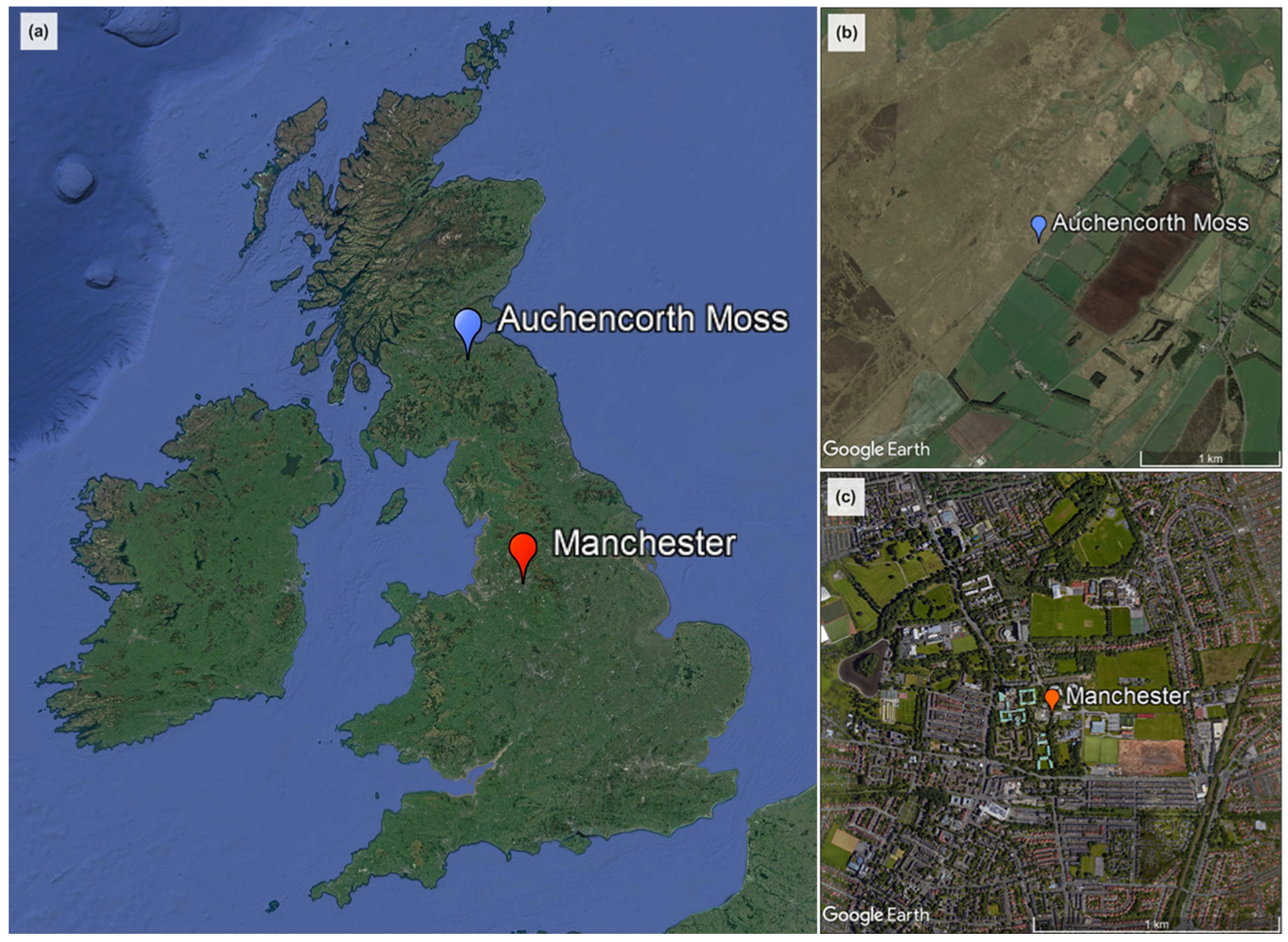
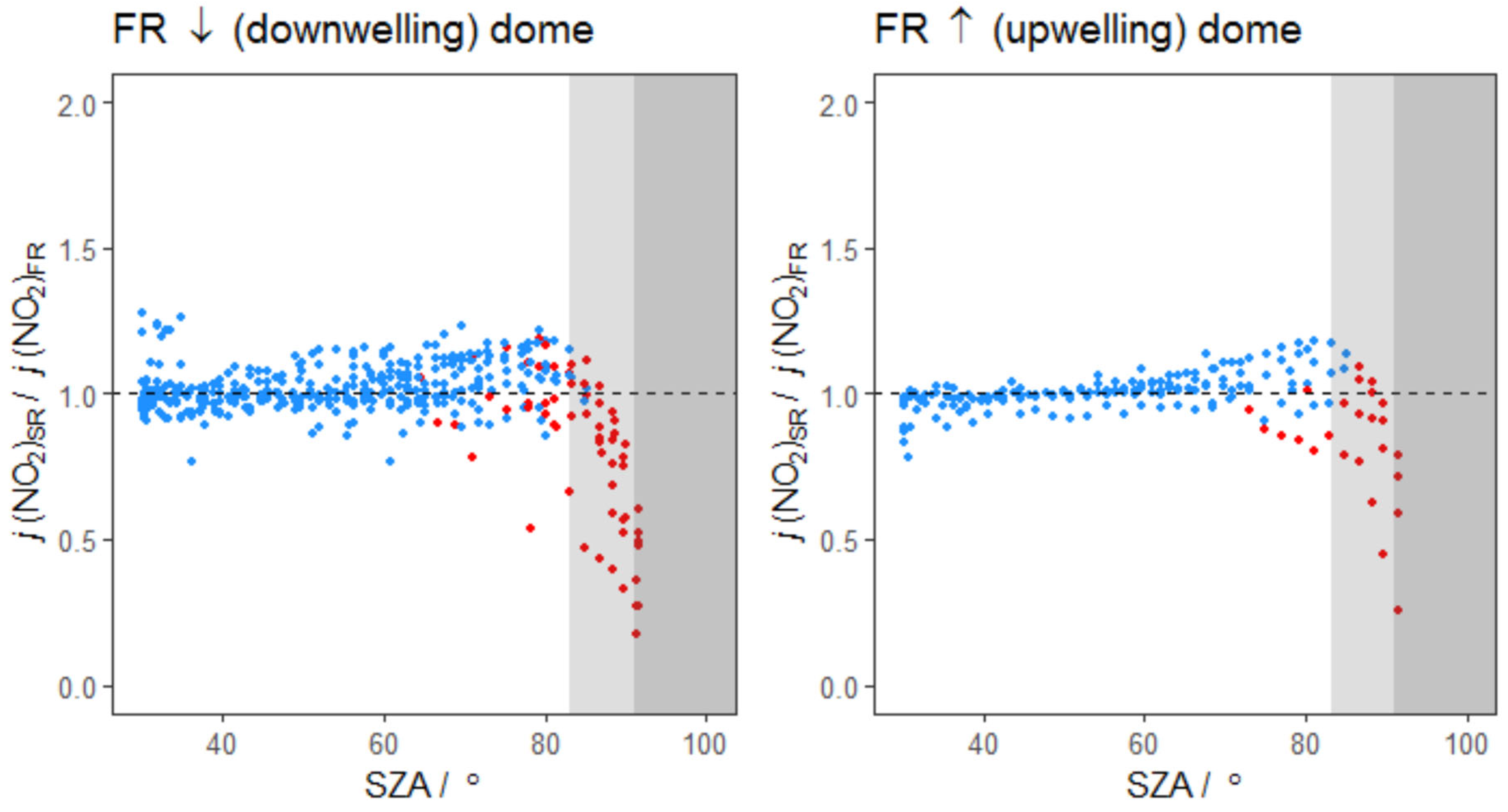

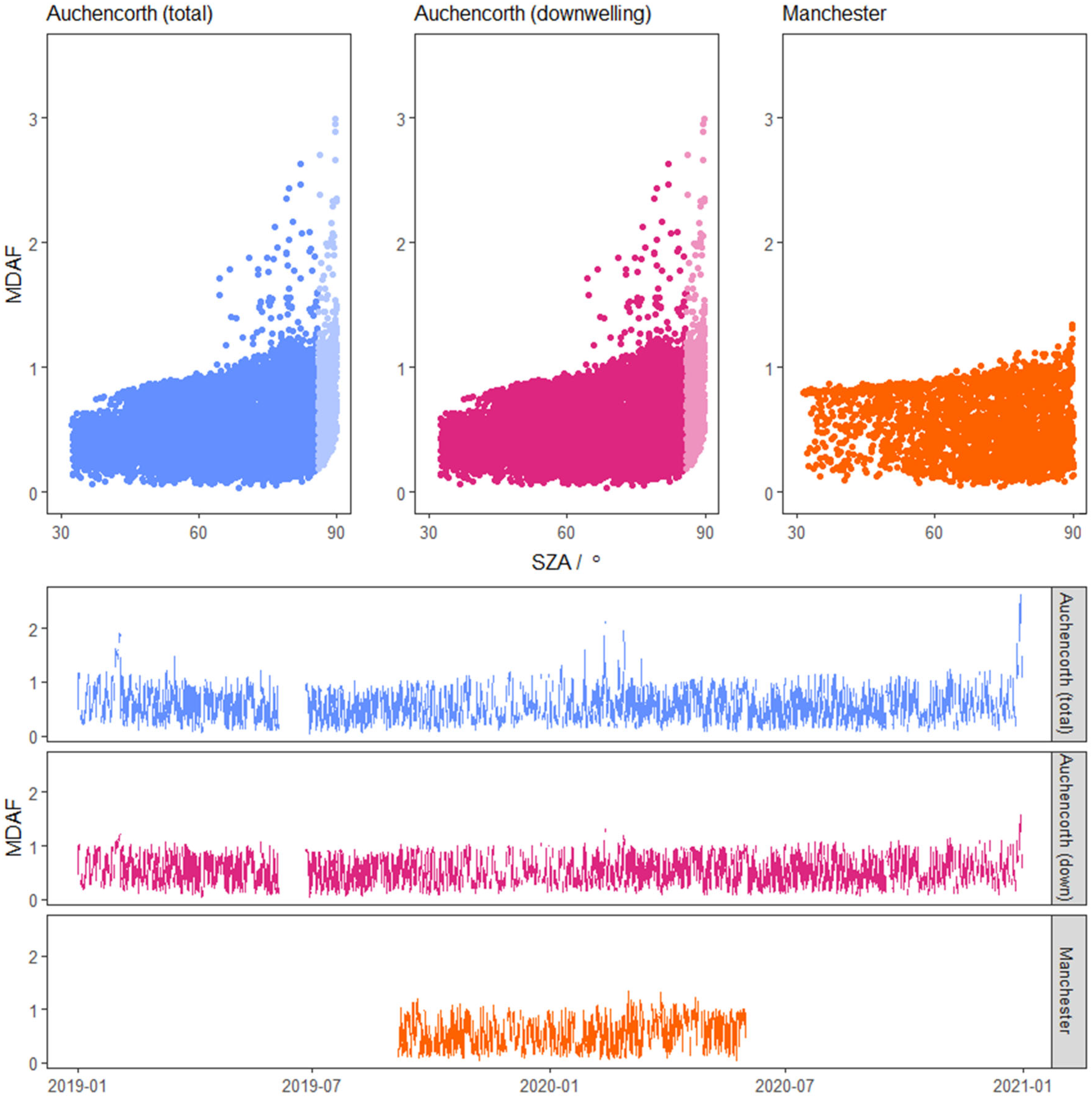
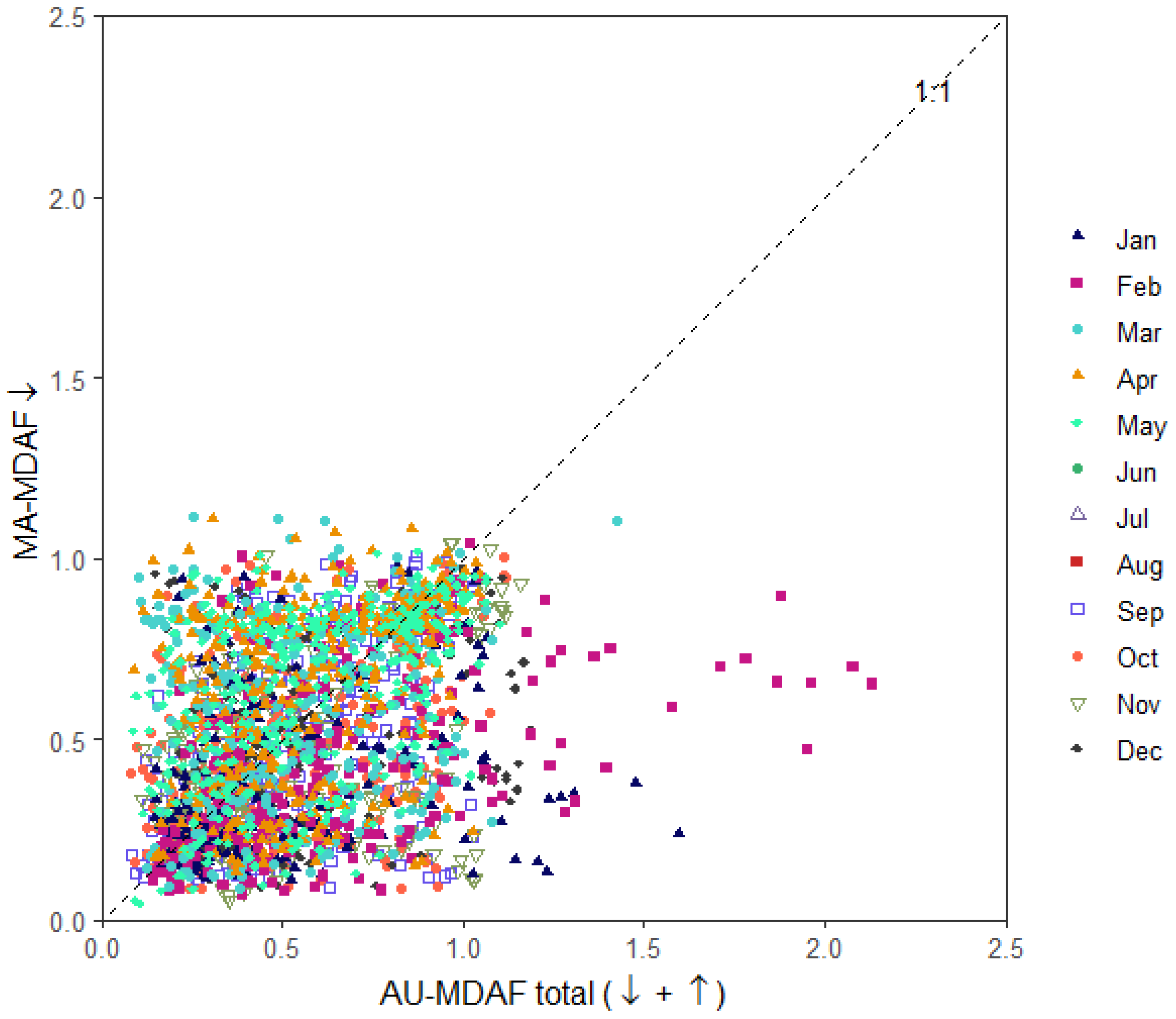
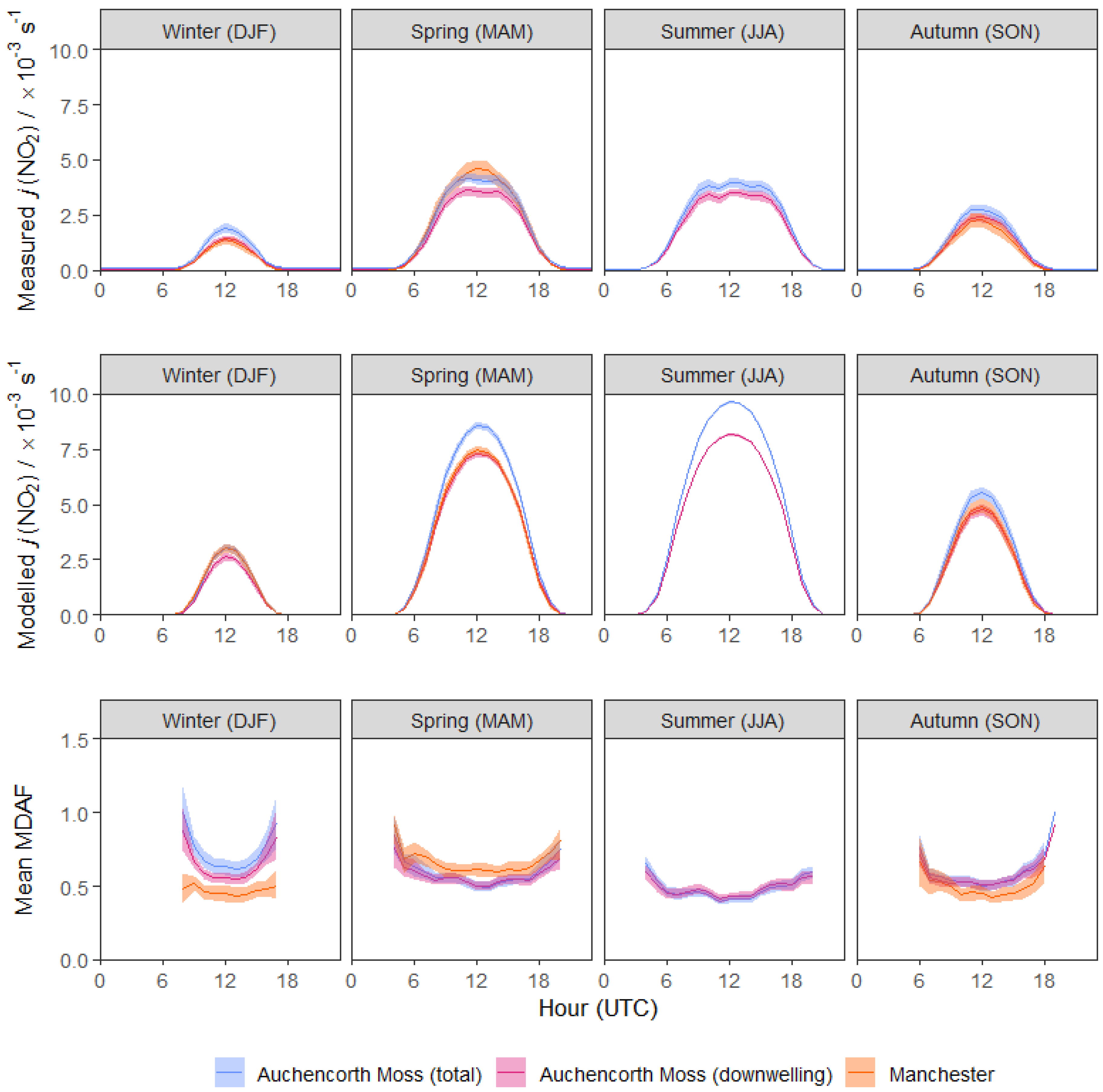

Publisher’s Note: MDPI stays neutral with regard to jurisdictional claims in published maps and institutional affiliations. |
© 2022 by the authors. Licensee MDPI, Basel, Switzerland. This article is an open access article distributed under the terms and conditions of the Creative Commons Attribution (CC BY) license (https://creativecommons.org/licenses/by/4.0/).
Share and Cite
Walker, H.L.; Heal, M.R.; Braban, C.F.; Leeson, S.R.; Simmons, I.; Jones, M.R.; Kift, R.; Marsden, N.; Twigg, M.M. The Importance of Capturing Local Measurement-Driven Adjustment of Modelled j(NO2). Atmosphere 2022, 13, 1065. https://doi.org/10.3390/atmos13071065
Walker HL, Heal MR, Braban CF, Leeson SR, Simmons I, Jones MR, Kift R, Marsden N, Twigg MM. The Importance of Capturing Local Measurement-Driven Adjustment of Modelled j(NO2). Atmosphere. 2022; 13(7):1065. https://doi.org/10.3390/atmos13071065
Chicago/Turabian StyleWalker, Hannah L., Mathew R. Heal, Christine F. Braban, Sarah R. Leeson, Ivan Simmons, Matthew R. Jones, Richard Kift, Nicholas Marsden, and Marsailidh M. Twigg. 2022. "The Importance of Capturing Local Measurement-Driven Adjustment of Modelled j(NO2)" Atmosphere 13, no. 7: 1065. https://doi.org/10.3390/atmos13071065





